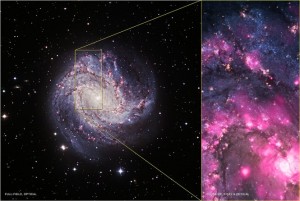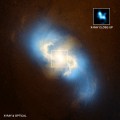An extraordinary outburst produced by a black hole in a nearby galaxy has provided direct evidence for a population of old, volatile stellar black holes. The discovery, made by astronomers using NASA’s Chandra X-ray Observatory, provides new insight into the nature of a mysterious class of black holes that can produce as much energy in X-rays as a million suns radiate at all wavelengths.
Researchers used Chandra to discover a new ultraluminous X-ray source, or ULX. These objects give off more X-rays than most binary systems, in which a companion star orbits the remains of a collapsed star. These collapsed stars form either a dense core called a neutron star or a black hole. The extra X-ray emission suggests ULXs contain black holes that might be much more massive than the ones found elsewhere in our galaxy. 
Image right: On the left is an optical image of M83 from the Very Large Telescope in Chile. On the right is a composite image showing X-ray data from Chandra in pink and optical data from the Hubble Space Telescope in blue and yellow. The ULX is located near the bottom of the composite image. (Left image – Optical: ESO/VLT; Close-up – X-ray: NASA/CXC/Curtin University/R. Soria et al., Optical: NASA/STScI/Middlebury College/F. Winkler et al.)
The companion stars to ULXs, when identified, are usually young, massive stars, implying their black holes are also young. The latest research, however, provides direct evidence that ULXs can contain much older black holes and some sources may have been misidentified as young ones.
The intriguing new ULX is located in M83, a spiral galaxy about 15 million light years from Earth, discovered in 2010 with Chandra. Astronomers compared this data with Chandra images from 2000 and 2001, which showed the source had increased in X-ray brightness by at least 3,000 times and has since become the brightest X-ray source in M83.
“The flaring up of this ULX took us by surprise and was a sure sign we had discovered something new about the way black holes grow,” said Roberto Soria of Curtin University in Australia, who led the new study. The dramatic jump in X-ray brightness, according to the researchers, likely occurred because of a sudden increase in the amount of material falling into the black hole.
In 2011, Soria and his colleagues used optical images from the Gemini Observatory and NASA’s Hubble Space Telescope to discover a bright blue source at the position of the X-ray source. The object had not been previously observed in a Magellan Telescope image taken in April 2009 or a Hubble image obtained in August 2009. The lack of a blue source in the earlier images indicates the black hole’s companion star is fainter, redder and has a much lower mass than most of the companions that previously have been directly linked to ULXs. The bright, blue optical emission seen in 2011 must have been caused by a dramatic accumulation of more material from the companion star.
The companion to the black hole in M83 is likely a red giant star at least 500 million years old, with a mass less than four times the sun’s.
Another ULX containing a volatile, old black hole recently was discovered in the Andromeda galaxy by Amanpreet Kaur, from Clemson University, and colleagues and published in the February 2012 issue of Astronomy and Astrophysics. Matthew Middleton and colleagues from the University of Durham reported more information in the March 2012 issue of the Monthly Notices of the Royal Astronomical Society. They used data from Chandra, XMM-Newton and HST to show the ULX is highly variable and its companion is an old, red star.
A paper describing these results will appear in the May 10th issue of The Astrophysical Journal.
NASA’s Marshall Space Flight Center in Huntsville, Ala., manages the Chandra program for NASA’s Science Mission Directorate in Washington. The Smithsonian Astrophysical Observatory controls Chandra’s science and flight operations from Cambridge, Mass.





